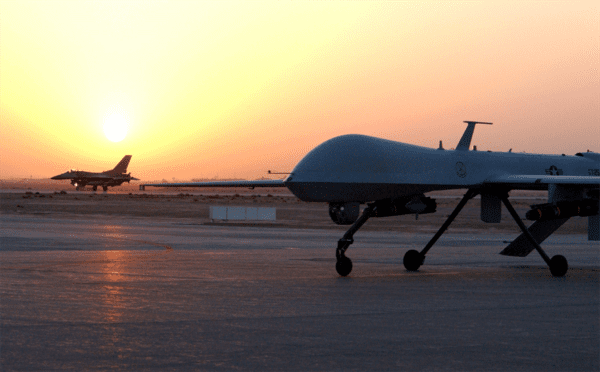
In a report released in July 2016, the Obama administration revealed the number of enemy combatants and civilians killed via drone strikes since 2009 in counter-terrorism efforts. This report came after President Obama signed an executive order with the intention of making the once-secret drone program more transparent and protective of citizens through the routine disclosure of civilian deaths. According to CBS News, the release claimed that 2,300 enemy combatants were killed and anywhere from 64 to 116 civilian deaths occurred as collateral damage. Controversy quickly circled around the U.S. government’s attempt at transparency in drone use. There was disagreement about the accuracy of the numbers reported. Critics also questioned whether the administration’s decision to disclose this information so soon after significantly expanding the counter-terrorism drone program was an attempt to mislead the public into thinking that they were being fully informed about drone warfare and its costs. Naureen Shah, an affiliate of the human rights organization Amnesty International, said “We’re going to be asking really hard questions about these numbers. They’re incredibly low for the number of people killed who are civilians.”
Watchdog groups suggest the U.S. government’s estimates of civilian death are exponentially lower than the real death toll. The Long War Journal, a blog run by the non-profit media organization Public Multimedia Incorporated, reported the civilian death toll at 207 from operations in Pakistan and Yemen alone. This was the lowest count provided by a watchdog groups. The Bureau of Investigative Journalism placed the death toll closer to “a maximum of 801 civilian deaths,” with a possible range of “anywhere from 492 to about 1,100 civilians killed by drone strikes since 2002.” Additionally, the government report excludes the numbers of casualties from Iraq, Afghanistan and Syria, places where the U.S. has conducted thousands of drone operations. The Bureau of Investigative Journalism generated its numbers from both local and international journalists, field investigations, NGO investigators, court documents and leaked government files.
Speaking for the accuracy of the government report, some argue that government officials have access to information the public does not. The U.S. government asserts that they utilize refined methodologies in calculating post-strike numbers, and they have access to information that is generally unavailable to non-governmental organizations. This information influences both the motivations for carrying out a drone strike as well as the validity of the number of casualties reported from various sources. Many terrorists groups spread incorrect information about the U.S. as propaganda which can mislead watchdog groups’ statistics. The report from the Obama administration voices this worry, stating that “The U.S. Government may have reliable information that certain individuals are combatants, but are being counted as non-combatants by nongovernmental organizations.”
All of this poses a problem for news reporters who rely on the government to supply information necessary for their stories. A lack of clarity in how the government defines terms such as “civilian” or “enemy combatant” in their reports causes a discrepancy in the interpretation of the information journalists then relay to the public. According to this view, the public deserves the unspun data on the costs of certain policies, no matter how bracing it may be. Josh Ernest, a spokesperson for the White House, countered: “There are obviously limitations to transparency when it comes to matters as sensitive as this.” According to such a position, government officials have access to the most accurate and thorough information, and are best equipped to make sense of it and to wisely use it in protecting national interests. For instance, the government may be best positioned to evaluate how many innocent civilians are worth putting at risk for successful targeting of a combatant. Some ambiguity, or possibly opacity, in reporting causalities due to drone warfare would then seem to be the best way to protect national security. How are we to balance the needs of the press, the citizenry, and those conducting drone operations for national security in our journalistic information gathering and story writing?
Discussion Questions:
- What are the values in conflict in the struggle over whether drone casualty figures are released?
- What are the concerns of the government, and what are the concerns of the press in reporting on drone casualties?
- Would there still be ethical worries if the government was obscuring or inflating only the combatant death estimates?
- Can you identify a creative way that the government can uphold some measure of transparency in its drone operations and still effectively pursue its military operations?
Further Information:
“Obama Administration Discloses Number of Civilian Deaths Caused by Drones.” CBS News, July 1, 2016. Available at: www.cbsnews.com/news/obama-administration-discloses-civilian-deaths-drones/
“White House Tally of Civilian Drone Deaths Raises ‘Hard Questions.’” CBS News, 5 July 2016, www.cbsnews.com/news/white-house-report-obama-administration-drones-civilian-casualties-raises-questions/
Director of National Intelligence. “Summary of Information regarding U.S. Counterterrorism Strikes outside Areas of Active Hostilities.” July 2016. Available at DNI Release on CT Strikes Outside Areas of Active Hostilities
Jack Serle, “Obama Drone Casualty Numbers a Fraction of Those Recorded by the Bureau.” The Bureau of Investigative Journalism, July 1, 2016. Available at: www.thebureauinvestigates.com/stories/2016-07-01/obama-drone-casualty-numbers-a-fraction-of-those-recorded-by-the-bureau
Scott Shane, “Drone Strike Statistics Answer Few Questions, and Raise Many.” The New York Times, July 3, 2016. Available at: https://www.nytimes.com/2016/07/04/world/middleeast/drone-strike-statistics-answer-few-questions-and-raise-many.html
Authors:
Sabrina Stoffels & Scott R. Stroud, Ph.D.
Media Ethics Initiative
University of Texas at Austin
April 27, 2018
Image: U.S. Air Force / 1st Lt. Shannon Collins
This case study can be used in unmodified PDF form for classroom or educational settings. For use in publications such as textbooks, readers, and other works, please contact the Center for Media Engagement.
Ethics Case Study © 2018 by Center for Media Engagement is licensed under CC BY-NC-SA 4.0



